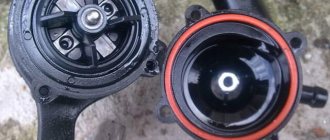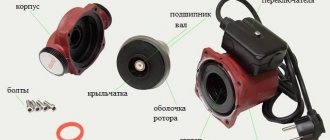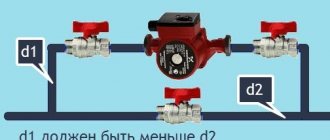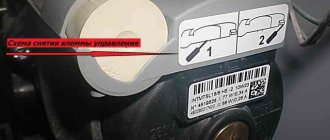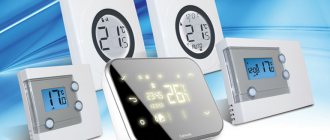Price
There are 2 lines of stabilizers designed specifically for circulation pumps of the heating system - Teplom and Slope:
Teplokom STT 222/500
It was created for heating systems where boilers with an open or closed combustion chamber are installed. It has a microprocessor control system, as well as technology that allows you to start the device immediately after the power supply is restored. It has wall mounts and can also be installed on the floor.
The price of such equipment does not exceed 3 thousand rubles.
On sale you can find a model that can be installed outdoors thanks to a housing that does not allow moisture to penetrate inside. The cost of such equipment will be slightly higher and reaches 4.5 thousand rubles.
Skat ST 1515
It is a UPS equipped with a voltage stabilizer. It is designed for certain voltage fluctuations in the network - up to 10% in each direction.
Its cost can reach 6 thousand rubles.
How to install the device correctly
Installation and installation of the UPS will not take much time, but you must follow some generally accepted rules.
Uninterruptible power supplies can be mounted either on the wall or installed on the floor. Those devices whose design allows for floor installation are often quite large in size. Due to their large dimensions, such UPSs are very rarely purchased for private homes.
The device should not be exposed to moisture or dust, so it is best to install the device in a special sealed cabinet or shield. Very often, UPSs are installed in the basement to save more space. The device is initially equipped from the factory with special fasteners that will significantly simplify the task. To connect an uninterruptible power supply to the pump, it is enough to accurately familiarize yourself with the diagram, which is often supplied as standard. If problems arise, it is best to contact specialists.
Criteria for selecting a backup power source
Backup power supplies designed to work with heating system pumps must be selected according to several characteristics:
- Power;
- Battery capacity;
- Acceptable battery life;
- Possibility of using external batteries;
- Input voltage variation;
- Output voltage accuracy;
- Time to switch to reserve;
- Output voltage distortion.
You should select a UPS for a circulation pump based on several basic parameters, the most important of which is power.
Determining the required UPS power
The electric motor, which is an integral part of the heating system pump, is an inductive reactive load. Based on this, the UPS power for the boiler and pump should be calculated. The technical documentation for the pump may indicate the power in watts, for example, 90 W (W). Thermal power is usually indicated in watts. To find out the total power, you need to divide the thermal power value by Cos ϕ, which can also be indicated in the documentation.
For example, the pump power (P) is 90W, and Cos ϕ 0.6. Total power is calculated using the formula:
Р/Cosϕ
Hence, the total power of the UPS for normal operation of the pump should be equal to 90/0.6=150W. But this is not the final result yet. When the electric motor starts, its current consumption increases approximately three times. Therefore, reactive power should be multiplied by three.
As a result, the UPS power for the heating circulation pump will be equal to:
P/Cosϕ*3
In the example given, the power supply will be 450 watts. If cosine phi is not indicated in the documentation, the thermal power in watts should be divided by a factor of 0.7.
Battery capacity
The capacity of the battery determines the time during which the heating system pump will operate in the absence of a network. The batteries built into the UPS usually have a small capacity, determined primarily by the size of the device. If the backup power source will operate under conditions of frequent and prolonged power outages, you should choose models that allow the possibility of connecting additional external batteries.
A very informative video about the personal experience of a person who was faced with purchasing an inverter for a boiler and heating pump, watch:
Input voltage
The mains voltage standard of 220 volts assumes permissible deviations of ± 10%, that is, from 198 to 242 volts. This means that all devices used on the territory of the Russian Federation must operate correctly within these limits. In fact, in various regions, and especially in rural areas, voltage deviations and surges can significantly exceed these values. Before purchasing a UPS for a heating pump, it will be very useful to measure the network voltage repeatedly throughout the day. The passport for the backup power supply indicates the permissible input voltage limits at which the device provides an output voltage close to the nominal value.
Output voltage and its shape
If the voltage parameters at the output of the uninterruptible power supply are within the permissible 10 percent, then this device is quite suitable for powering the heating system pump. The time it takes for the control board to switch to battery power usually does not exceed tens of microseconds. For an electric motor, this parameter is not critical.
A very important parameter of the UPS, necessary for the correct operation of the heating system pump, is the shape of the output signal. The pump electric motor requires a smooth sinusoid, which, of all models of backup power sources, can only be provided by a double conversion device or an on-line UPS. In addition to the ideal sine wave at the output, this source also produces an accurate voltage and frequency.
When installing a UPS for a heating pump, you should follow some rules:
- The room temperature must correspond to the values specified in the documentation;
- There should be no vapors of caustic reagents or flammable liquids in the room;
- The grounding circuit must be made in accordance with the operating rules for electrical installations.
UPS models
Energy PN-1000 is a powerful source of backup power. Thanks to the built-in stabilizer, the device provides the rated output voltage when the mains voltage changes within the range of 120-275 volts. The smooth sine waveform is ideal for powering a reactive inductive load, such as a heating system pump motor. The energy of the PN-1000, together with the Delta DTM 12100L 100A/h battery, provides uninterrupted power for a 150W heating pump for 8 hours. The device has a built-in network noise filter, information display and RS-232 interface.
You can find this and other voltage stabilizers for heating systems from the Energia company on the website of the official representative of the company VoltMarket.ru.
The compact emergency power source Teplokom 222/500 is designed for use in gas heating systems.
This simple device with a single-phase relay-type stabilizer ensures operation with a load not exceeding 230 W. The universal stabilizer Skat ST 1515 provides a voltage of 220 V with network fluctuations from 145 to 260 V and a frequency of 50 Hz ± 1%. If the voltage value exceeds the specified parameters, the load will be turned off automatically.
Let's sum it up
Based on the operational requirements for electric motors of heating system pumps, the UPS must provide the following parameters:
- Voltage shape – smooth sinusoid;
- Power reserve – at least 20%;
- Automatic load shedding;
- Minimum switching time to reserve.
In addition, the device must operate in a certain temperature range and have a device for indicating modes and physical quantities.
With this they read:
Uninterruptible power supply for a gas boiler: types, features and selection criteria
Industrial voltage stabilizer: what criteria should you use to choose?
Types and circuits of voltage stabilizers
Voltage stabilizer for a gas boiler: types, selection criteria and power calculation
Did you like the article? Share with friends on social networks!
DIY UPS for circulation pump
In winter and summer, when many electrical appliances are connected to the network, from fans and air conditioners to heaters, voltage drops are common. Such fluctuations, as well as power outages, negatively affect heating boilers, or rather, the electronics that control the operation of the boilers. Uninterruptible power supplies come to the rescue in such situations. An uninterruptible power supply for a heating pump can be purchased or made by yourself.
The simplest solution is to upgrade computer UPSs. For these purposes, you can purchase used uninterruptible power supplies. Increasing the battery life of an uninterruptible power supply is possible when using batteries such as Fiamm, CSB, Leoch, Ventura. It is advisable to place batteries away from heat sources and prevent them from freezing.
When using used computer uninterruptible power supplies, you must first throw away the faulty internal batteries. We produce contact clamps for connecting external batteries. For convenience, we make the clips in different colors. Operating batteries for a long time causes them to overheat. To avoid overheating and premature failure of the device, it is necessary to install fans to cool the system.
DIY UPS
Since the cold may come earlier and the heating season, accordingly, too, it is necessary to take care of the heating system in advance and connect it to the network via a UPS. It is better to check the functionality of the entire system in advance in order to protect your wallet from additional expenses at the wrong time.
Whether you live in an apartment building or a private one, in a village or a metropolis, if you have a heating system that depends on the operation of electronics and network voltage, you need an uninterruptible power supply for the heating pump with the ability to operate autonomously. Whether you buy a ready-made UPS or make it yourself is up to you. In any case, the UPS will protect volatile equipment from power surges or complete power outages and will save you from costly repairs. The number of external batteries depends on the desired battery life of the system in the event of a power outage.
What types of UPS output a sinusoidal signal?
In general, there are 3 main types of uninterruptible power supplies:
- backup or off-line;
- linear-interactive;
- with double converter or on-line.
Reserve ones are the cheapest and simplest.
The scheme of their work looks like this:
— in mains mode
- in battery mode
Usually the name of backup uninterruptible power supply systems contains the designation Back . Most often, if you have a Back-UPS in front of you, you don’t even have to hope for a sine wave. According to the diagram, the characteristics of the output signal when operating on batteries will depend on the inverter. In inexpensive Back-UPS it is extremely rare to find expensive inverters with voltage conversion to a sine wave.
Among the models of line-interactive UPS, the chance of buying an uninterruptible power supply with a pure sine wave is much higher. Linear-interactive uninterruptible power supplies can often be distinguished by the presence of the Smart prefix in the name, although recently Back models can also be produced with this operating scheme. It remains to be seen what the manufacturer writes about the characteristics of the model’s output signal. UPSs with the correct sine wave of this type are produced by many leading manufacturers - APC, PowerCom and others.
Due to the optimal price-quality ratio, the following are especially popular among domestic consumers:
- UPS company LogicPower, which named the corresponding product line - line-interactive UPS with the correct sine wave.
- Uninterruptible power supplies Luxeon.
- UPS ProLogix.
The third type of UPS - double conversion - is the most expensive, but here you will 100% get an ideal sinusoidal signal at the output. In addition, its operating scheme assumes that the inverter operates constantly, not only when switching to batteries:
This gives additional benefits:
- no interference;
- almost instantaneous switching to battery operation;
- constant stabilization of the signal in real time with minimal delays.
In addition, the online UPS allows you to connect external batteries and thus increase the operating time of the equipment during a power outage to significant amounts.
Examples of selecting uninterruptible power supplies for pumps of various capacities
Let's look at a few examples of the correct choice of equipment.
- It is necessary to provide uninterrupted power to a 50 W circulation pump. We estimate the value of the starting current, 50 W x 4 = 200 W. Therefore, an uninterruptible power supply is required for a pump with a power of at least 200 W. The optimal solution would be the TEPLOCOM-300 uninterruptible power supply. We decide on the choice of UPS configuration and external battery. The TEPLOCOM-300 UPS with a 65 Ah battery is capable of providing autonomous power to a 50 W pump for approximately 12 hours. The TEPLOCOM-300 uninterruptible power supply with a 100 Ah battery is capable of providing autonomous power to a 50 W pump for approximately 20 hours.
- It is necessary to provide uninterrupted power to a circulation pump with a power of 80 W. We estimate the value of the starting current, 80 W x 4 = 320 W. Therefore, an uninterruptible power supply is required for a pump with a power of at least 300 W. The optimal solution would be the TEPLOCOM-300 uninterruptible power supply. We decide on the choice of UPS configuration and external battery. The TEPLOCOM-300 uninterruptible power supply with a 65 Ah battery is capable of providing autonomous power to an 80 W pump for approximately 7 hours. The TEPLOCOM-300 uninterruptible power supply with a 100 Ah battery is capable of providing autonomous power to an 80 W pump for approximately 12 hours. If it is necessary to provide a longer reserve, we can suggest using a more powerful TEPLOCOM-1000 uninterruptible power supply. This uninterruptible power supply works with two external batteries. The TEPLOCOM-1000 uninterruptible power supply with two batteries of 100 Ah each is capable of providing autonomous power to an 80 W pump for approximately 27 hours. The TEPLOCOM-1000 uninterruptible power supply with two batteries of 150 Ah each is capable of providing autonomous power to an 80 W pump for approximately 40 hours.
- It is necessary to provide uninterrupted power to circulation pumps with a total power of 160 W. We estimate the value of the starting current, 160 W x 4 = 640 W. Therefore, an uninterruptible power supply is required for a pump with a power of at least 640 W. The optimal solution would be the TEPLOCOM-1000 uninterruptible power supply. We decide on the choice of UPS configuration and external battery. This uninterruptible power supply works with two external batteries. The TEPLOCOM-1000 uninterruptible power supply with two batteries of 100 Ah each is capable of providing autonomous power to pumps with a total power of 160 W for approximately 11 hours. The TEPLOCOM-1000 uninterruptible power supply with two batteries of 150 Ah each is capable of providing autonomous power to pumps with a total power of 160 W for approximately 17 hours. The TEPLOCOM-1000 uninterruptible power supply with two batteries of 200 Ah each is capable of providing autonomous power to pumps with a total power of 160 W for approximately 24 hours. If it is necessary to provide a longer reserve, we can suggest using a more powerful uninterruptible power supply SKAT-UPS 1000 version. D. This UPS works with three external batteries. The SKAT-1000 uninterruptible power supply with three batteries of 150 Ah each is capable of providing autonomous power to pumps with a total power of 160 W for approximately 28 hours. The SKAT-UPS 1000 uninterruptible power supply with three batteries of 200 Ah each is capable of providing autonomous power to pumps with a total power of 160 W for approximately 40 hours.
- It is necessary to provide uninterrupted power to circulation pumps with a total power of 240 W. We estimate the value of the starting current, 240 W x 4 = 960 W. Therefore, an uninterruptible power supply is required for a pump with a power of at least 960 W. The optimal solution would be the TEPLOCOM-1000 uninterruptible power supply. We decide on the choice of UPS configuration and external battery. This uninterruptible power supply works with two external batteries. The TEPLOCOM-1000 uninterruptible power supply with two batteries of 150 Ah each is capable of providing autonomous power to pumps with a total power of 240 W for approximately 11 hours. The TEPLOCOM-1000 uninterruptible power supply with two batteries of 200 Ah each is capable of providing autonomous power to pumps with a total power of 240 W for approximately 15 hours. If it is necessary to provide a longer reserve, you can use a more powerful uninterruptible power supply SKAT-1000. D. This UPS works with three external batteries. The SKAT-UPS 1000 uninterruptible power supply with three batteries of 150 Ah each is capable of providing autonomous power to pumps with a total power of 240 W for approximately 18 hours. The SKAT-1000 uninterruptible power supply with three batteries of 200 Ah each is capable of providing autonomous power to pumps with a total power of 240 W for approximately 25 hours.
Why do you need an uninterruptible power supply to power heating and water supply pumps?
How to assess the need to use uninterruptible power supplies to organize reliable uninterruptible power supply for heating pumps and other pumping equipment? Stable and efficient operation of water supply and heating systems is very important for the normal life of any person. Failure of these systems can cause extensive damage to your home, making your home uninhabitable. Large deviations in electrical power parameters and interruptions in the current supply can lead to shutdowns of the house's engineering systems or breakdown of expensive pumping and heating equipment. It is for this reason that it is necessary to ensure uninterrupted (or backup) electrical power. To do this, you can install uninterruptible power supplies for pumps or use backup power plants.
UPS selection and power determination
There are two main types of uninterruptible power supply:
- Line-interactive, Line-interactive. Performs the functions of an energy storage and stabilizer. It produces a sinusoid at the output and compensates for increases and decreases in voltage. The noise level of the device is up to 40 dB. Mode switching time is about 3 – 5 Moscow time.
- On-line, or double conversion. This device is capable of ensuring the supply of the highest quality electricity from the network. The essence of its work is that the energy is first converted into direct current, supplied to charge the batteries, and it immediately turns into alternating current of the required magnitude. In addition, the transition time from mode to mode tends to 0. It is more often used for sensitive electronics, for servers and computers. It is also worth choosing this type of UPS if, in addition to the pump, a boiler with its demanding electronics will be connected to it.
The double conversion system is an energy-consuming process, so devices of the second type heat up more, make noise and lose efficiency (70%, versus 90 - 95% for an interactive one).
Number of phases. Uninterruptible power supplies can be single or three-phase. The latter are most often used for industrial equipment. For the heating system of a private house, single-phase models are chosen.
The power of the UPS is selected based on the total power of all nodes connected to it. It should be taken into account that during startup, the load increases several times. In the documentation for the circulation pump, this indicator is stated as “Starting current”. When selecting the power of a UPS, this value must be taken as a basis, otherwise the uninterruptible power supply may fail from the very first start. The exception is pumps with a soft start function.
UPS Helior
Example. Circulation pump power – 250 W. The current multiplicity at start-up is 4. This means that the starting power = 250 x 4 = 1000 W. Accordingly, a UPS must be purchased with a power of 1 kW and above.
Operating voltage range. This indicator is calculated based on voltage drops in a particular network. If, for example, these fluctuations reach ± 9%, then an uninterruptible power supply with a range of 220 ± 10% is purchased. If you do not calculate this indicator, the uninterruptible power supply will switch the pump to autonomous operation (from the battery) every time the voltage in the network jumps. And such a mode with frequent transitions will quickly disable it.
Some models can be equipped with:
- Cold start function. Makes it possible to turn on the uninterruptible power supply when the electricity has already been turned off.
- Equipment status indicators.
- Alarm about critical charge level.
- Microprocessor control.
- Self-diagnosis during switching on.
- LCD display.
There are floor-standing models, similar to a computer system unit (the most common), and wall-mounted ones.
When choosing the power of single-phase equipment, it makes sense to choose a device with a power reserve. This will ensure longer operating time and also make it possible to connect other devices to the UPS in the future.
How to choose an uninterruptible power supply for a heating pump?
When purchasing an emergency power supply, take into account the power, battery life, the possibility of introducing additional batteries, and the transition time to battery operation.
Selection by type
Double conversion UPSs have the most suitable characteristics for powering heating equipment. They provide a stable voltage, smooth out fluctuations, and block high-frequency interference. Inverter uninterruptible power supplies support the operation of boilers equipped with complex electronic modules.
The only drawback is the increased noise level emitted by the coolers.
Linear UPSs are low cost. Such devices do not stabilize the voltage supplied from the network. A sudden change in current parameters can damage heating equipment. However, linear sources have the highest efficiency.
By power
The required parameter is indicated in the technical data sheet of the pump. The value is multiplied by 3 and the required UPS power is obtained. The need to perform this action is explained by the reactive load of the pump. When turned on, the device consumes 2-3 times more current. Therefore, when calculating, a power reserve is provided.
Battery capacity
Inexpensive models can work offline for no more than 5 hours. The built-in rechargeable batteries accumulate little charge. If power outages occur regularly, choose a UPS with a rating of more than 100 A. A pump powered by such a device can operate for 12-24 hours.
The recommended battery type is maintenance-free gel battery. In this case, the user does not have to monitor the electrolyte level.
Input and output voltage error
The smaller the output error, the lower the likelihood of heating equipment failure. The recommended value is no more than 5%. The largest deviations are found at the input. To power the pump, choose an uninterruptible power supply that can accept a wide range of input voltage (180-250 V).
Types of UPS for pumps
The modern device market is ready to offer its customers a huge selection of UPS.
If you already have a circular pump, then finding an uninterruptible power supply for it will not be difficult. Despite the abundance of types of equipment, any uninterruptible heating system pump consists of several main parts. There are several main types of equipment that you should familiarize yourself with in more detail.
Reserve
The standard operating mode of the pump involves direct connection to the network. The UPS acts as a noise filter in this circuit. If it happens that for some reason the voltage disappears, the load will be supplied automatically. Energy is supplied using an inverter from batteries. The efficiency is 99% - this is an extremely good indicator. During its operation, the device creates virtually no noise and little heat.
But there is a small drawback - it takes a long time to switch to batteries, as well as the inability to control the frequency of the current.
Interactive
The schematic diagram of such uninterruptible power supplies for heating is practically no different from the backup type, however, there is one caveat: at the input there is a step stabilizer, which is based on an autotransformer and fully ensures switching and power regulation. If we consider the normal operating mode of the device, we can note that the current frequency is not adjusted here, but passive filters operate. If the current suddenly disappears, the reserve will be supplied using the same inverter. Device switching is faster. This is possible due to the inverter and input current, but the efficiency is slightly lower. Operating from the primary network, it is capable of providing fairly simple stabilization.
The negative feature is that when powered by a battery, the device provides a frequency slightly higher than 50 Hz.
Double conversion
Such an uninterruptible power supply for a heating pump is usually used for powerful equipment that requires high-quality electricity. The device itself converts alternating current into direct current, and then back again. The advantage of such a device is that when the current disappears, connecting the batteries to the uninterruptible power supply is not required, because they are constantly connected to the network. Another positive quality is the lack of switching time. The uninterruptible power supply is capable of adjusting the frequency of current and voltage, while creating an ideal sinusoid. Uninterrupted power supply to the circulation pump is almost guaranteed.
Types of uninterruptible power supplies
When choosing an uninterruptible power supply for a heating circulation pump, you should pay special attention to its technical characteristics. First, let's define the types of this equipment:
- Linear uninterruptible power supplies (backup) are extremely simple. There is no stabilization of the input voltage; when powered from the mains, it fluctuates over a wide range. When the power supply is turned off, the equipment is powered by a built-in or plug-in battery;
- Line-interactive uninterruptible power supply units – models with voltage stabilization function. They are built on the basis of autotransformers;
- UPS for a double conversion heating circulation pump is the most complex uninterruptible power supply. The first converter outputs a constant voltage, from which the batteries are charged. The second converter outputs alternating current with a voltage of 220 Volts.
Uninterruptible power supplies with double conversion are complex, but the most stable. They do not use direct power supply to consumers from the mains - the current undergoes double conversion.
The optimal purchase for powering a circulation pump would be an uninterruptible power supply with double voltage conversion (inverter for a heating pump).
Operating principle and design of the UPS
The name itself shows the purpose of the device - to provide uninterrupted power supply from a reserve when the main source is turned off. The first uninterruptible power supplies appeared after the creation of computers and were intended to maintain high-quality power supply and short-term continuation of work after the main power was turned off. The UPS filters the incoming voltage, and if it does not meet the required parameters or disappears, it automatically supplies power to the consumer.
The UPS consists of the following main components:
- power switching system (bypass);
- Charger;
- DC to AC converter;
- governing body;
- battery.
Internal Components
A switch is needed to switch the voltage source. The working element can be a power relay (in cheap models), thyristors, and recently IGBT transistors have begun to be used. The response time ranges from 6–10 ms. The ability to switch a current of a certain power affects the power of the entire device. In interactive circuits, the commutator is also used to switch the terminals of the autotransformer windings.
The charger unit converts the input AC voltage into a rectified voltage of the required value to charge the battery. This device will determine which batteries can be charged.
The conversion of the battery's direct current into alternating voltage is carried out by an inverter. It is he who is responsible for the voltage quality and power of the UPS. The battery is the source of energy for such a conversion, and its capacity will determine how long the uninterruptible power supply can provide energy to consumers.
Schematic diagram
Electrical components, buttons, and switches act as the control body. LCD screens can be used for visual control. According to the principle of operation of UPS for heating there are:
- reserve;
- interactive;
- double conversion.
To understand what is their difference, it is worth analyzing each circuit; in the future, this will help solve the question of how to choose a UPS?
Reserve
The simplest circuit uses a simple filter at the input that can delay high-voltage and electromagnetic pulses; it is made in the form of a capacitor (C) or a coil and capacitor (LC). The load is connected directly to the network. If the power quality deteriorates significantly or if it disappears, the supply voltage is supplied from the UPS. Used in simple and cheap models. Often used to power computers, it has a high efficiency of about 99%.
Appearance of a computer UPS
The disadvantage is the complete lack of ability to change the voltage amplitude and frequency of the mains current. The inverter circuit is simplified as much as possible, which leads to distortions in the shape of the sine wave. Instead of a sinusoid, as a rule, there are rectangular signals. They are not dangerous for the computer, since the current is immediately rectified.
For lighting and heating devices, the signal shape does not matter.
Linear interactive
This circuit is more suitable for an uninterruptible power supply for all heating system pumps. The main difference from the previous circuit is the ability to change the input voltage. To do this, a transformer is installed in the input circuit, the primary winding of which has several terminals; it acts as a stabilizer.
At rated voltage, no adjustment is made, and if the balance is disturbed, additional turns are automatically connected or disconnected. This stepwise switching allows the battery to be used less, which significantly extends its life.
Interactive UPS diagram
The inverters used produce rectangular, trapezoidal, step or sinusoidal voltage, it all depends on the complexity of the device. Naturally, this affects the cost.
